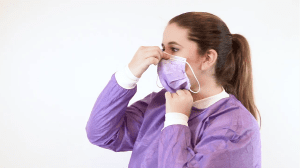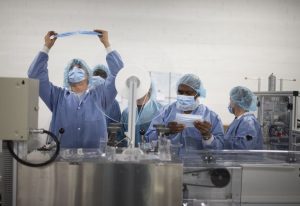
When COVID-19 created an unprecedented demand for personal protective equipment (PPE), many countries were caught off guard. Without sufficient stockpiles of items such as masks, gowns and gloves, many frontline healthcare workers were forced to reuse disposable items or go without. As demand began to surpass available supply from reputable manufacturers, companies and individuals were eager to profit from the situation and began producing face masks. However, many had no medical device manufacturing experience and no knowledge of the regulatory requirements that are in place to keep healthcare professionals safe. Unfortunately, their masks did not provide adequate protection against virus transmission and some even contained potentially harmful materials* that put wearers’ health further at risk.
Producing medical grade face masks that provide medical professionals with safe and reliable respiratory protection requires extensive knowledge and experience. That’s why it’s critical to purchase respiratory protection only from a knowledgeable and experienced mask manufacturer that uses high-quality raw materials, state-of-the art manufacturing techniques and stringent quality controls that meet all regulatory standards.
In the midst of a pandemic of a virus that is as highly transmissible as Covid-19 and the current Delta variant in particular, choosing a mask that meets these standards is more important than ever.
What are Australian standards for medical face masks?
The AS 4381:2015 standard classifies masks into three levels (1, 2, 3). All levels have different purposes and are for different environments. The medical masks that meet the Australian Standards are measured in accordance with three performance parameters.
Bacterial Filtration Efficiency (BFE)
BFE measures how well a mask filters out bacteria when challenged with a bacteria-containing aerosol. AS 4381 specifies testing with a droplet size of 3.0 microns containing Staphylococcus aureus (average size 0.6-0.8 microns). To qualify as a medical mask, a minimum 95% filtration rate is required. Moderate and high-level protection masks must have bacterial filtration rates greater than 98%.
Pressure Differential (Delta P)
Delta P measures a mask’s air flow resistance and provides an objective measure of its breathability. The Delta P is measured in units of mm H2O/cm2. The lower the value, the more breathable the mask. AS 4381 Delta P requirements:
Level 1 masks: less than 4.0
Level 2 and 3 masks: less than 5.0
Synthetic Blood Penetration
The synthetic blood penetration measures the mask’s ability to act as a barrier to blood-borne pathogens before filtering through the mask. AS 4381 specifies testing with synthetic blood at pressures of 80, 120 or 160mm Hg to qualify for low, medium, or high fluid resistance. These pressures correlate to blood pressure:
80 mm Hg = Level 1
120 mm Hg = Level 2
160 mm Hg = Level 3
What protection level do you need?
It is recommended that you choose your mask’s barrier protection level based on its intended use. Revised from previous (AS) 4381: 2002 for ‘Single-use face masks for use in health care’, The current 2015 version of the Australian Standard is aligned with the North American ASTM F2100-11 and European (EN) 14683.
AS 4381:2015 LEVELS OF PROTECTION AND EXAMPLES OF APPLICATIONS
| Level 1 | Level 2 | Level 3 |
| Level 1 barrier medical face mask materials are evaluated for resistance to penetration by synthetic blood, bacterial filtration efficiency and differential pressure as stated below | Level 2 barrier medical face mask materials are evaluated for resistance to penetration by synthetic blood, bacterial filtration efficiency and differential pressure as stated below | Level 3 barrier medical face mask materials are evaluated for resistance to penetration by synthetic blood, bacterial filtration efficiency and differential pressure as stated below |
| Applications | Applications | Applications |
| For general purpose medical procedures, where the wearer is not at risk of blood or body fluid splash or to protect staff and/or the patient from droplet exposure to microorganisms (e.g., patient with upper respiratory tract infection visits General Practitioner). | For use in emergency departments, dentistry, changing dressings on small wounds or healing wounds where minimal blood droplet exposure may possibly occur (e.g., endoscopy procedures). | For all surgical procedures, major trauma first aid or in any area where the health care worker is at risk of blood or body fluid splash (e.g. orthopaedic, cardiovascular procedures). |
AS 4381:2015 CHARACTERISTICS OF LEVELS OF BARRIER PROTECTION
| Characteristics | Level 1 | Level 2 | Level 3 | Test Method |
| Bacterial filtration efficiency (BFE), % | ≥95 | ≥98 | ≥98 | ASTM F2101-14 or EN 14683:2014 |
| Differential pressure (ΔP), mm H2O/cm2 | <4.0 | <5.0 | <5.0 | EN 14683:2014 |
| Resistance to penetration by synthetic blood, minimum pressure in mm Hg for pass result | 80 mmHg | 120 mmHg | 160 mmHg | ASTM F1862/F1862M-13 or ISO 22609 |

When you wear a mask all day, comfort matters
While newcomers to medical mask manufacturing have been eager to produce the fastest and cheapest masks, reputable medical mask manufacturers have a vested interest in maintaining their reputation for providing safe and reliable respiratory protection that is also comfortable to wear, even during the longest shifts.
With healthcare professionals currently wearing masks for longer periods of the day than ever, mask breathability and comfort are more important than ever. Mask experts like Medicom, have been manufacturing PPE for over 33 years, know how to produce medical masks that not only provide reliable respiratory protection, but that are also highly breathable and gentle on skin.
Medicom developed its specialised medical mask expertise in close collaboration with the healthcare professionals who wear them. By investing in ongoing research and development, premium raw materials and state-of-the art machinery, the company continues to produce innovative, premium-quality masks that meet the needs and preferences of those who wear them.

